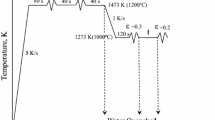Abstract
Lattice defects are introduced into stable austenite (β) by hot rolling up to 70% (in one pass) in a temperature range between 900 > TAF > 340 °C (ausforming (AF)). The changes in microstructure, thermal transformation behavior, as well as normal and anomalous properties in stress-, strain-, and temperature-space were studied. Martensitic transformation temperatures are lowered with decreasing deformation temperature and increasing amount of deformation. A two-stage reaction is induced at TAF ≤ 400 °C. Deformation twins are the predominant microstructural feature, in addition to dislocations at TAF ≤ 700 °C. Highly elongated grains indicate that long-range recrystallization is absent at all ausforming temperatures. Semicoherent pecipitation in addition to high dislocation densities are likely to be responsible for the premartensitic anomalies of thermal transformation for TAF ≤ 400 °C. Ausforming leads to a considerable increase in conventional strength properties (yield stress, tensile strength, elongation) without loss of transformability and, consequently, shape memory or pseudo-elasticity.
Similar content being viewed by others
References
V. F. Zackey, et al., in "The Relation between Microstructure and Mechanical Properties," (H. M. S. O., London, 1963) p. 847.
E. Hornbogen, in "Innovation in Ultra High Strength Steel Technology," edited by G. B. Olson Proceedings of the thirtyfourth Sagamore Conference, Lake George, NY (1983) p. 113.
M. Thumann and E. Hornbogen, Z. Met. kd. 79 (1988) 119.
M. Franz and E. Hornbogen, ibid. 86 (1995) 31
E. Hornbogen, in "Engineering Aspects of SMA," edited by T. W. DUERIG et al. (Butterworth, London, 1990) pp. 267–280.
E. Hornbogen and E. Kobus, Prakt. Metallogr. 30 (1993) 507.
R. W. Cahn and J. A. Coll, Acta Metall. 9 (1961) 138.
M. J. Marcinkowski, in "Electron Microscopy and Strength of Crystals," edited by G. Thomas and J. Washburn (Wiley, NY, 1963) p. 333.
E. Hornbogen, Acta Metall. 33 (1985) 595.
E. Hornbogen, in "Micromechanisms of Advanced Materials," edited by S. N. G. Chun et al., (T. M. S.Warrendale, Pa, 1995) p. 307.
K. N. Melton and O. Mercier, Scr. Metall. 13 (1970) 73.
J. Perkins and W. E. Muesing, Metall. Trans. A. 14 (1983) 93 and Acta Metall. 27 (1979) 137.
M. Sade and E. Hornbogen, Z. Metallkde. 79 (1988) 678.
E. Patoor and M. Berveiller (Eds), "Technologie des Alliages `a M´emoir de Forme," (Hermes, Paris 1994).
Rights and permissions
About this article
Cite this article
Hornbogen, E. Ausforming of NiTi. Journal of Materials Science 34, 599–606 (1999). https://doi.org/10.1023/A:1004563216567
Issue Date:
DOI: https://doi.org/10.1023/A:1004563216567




